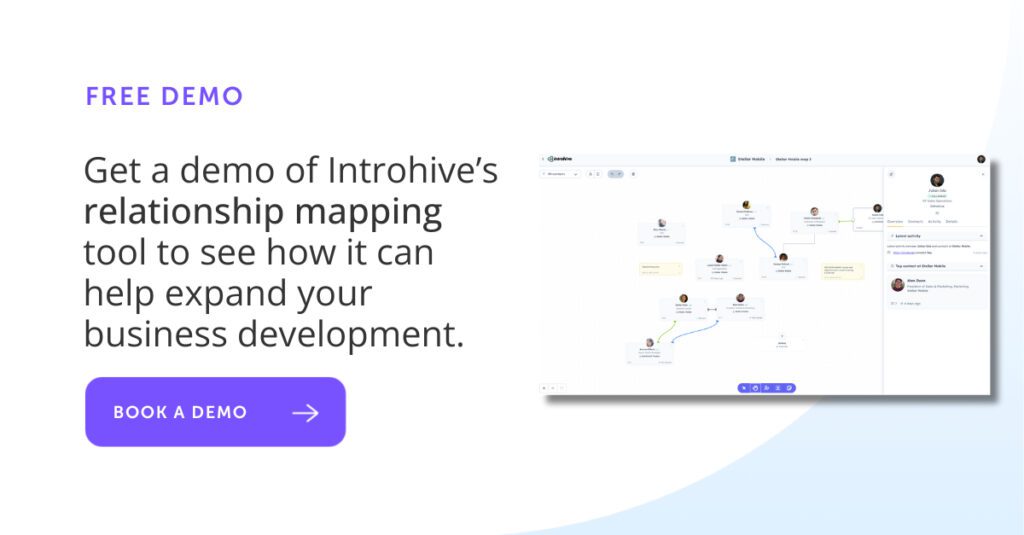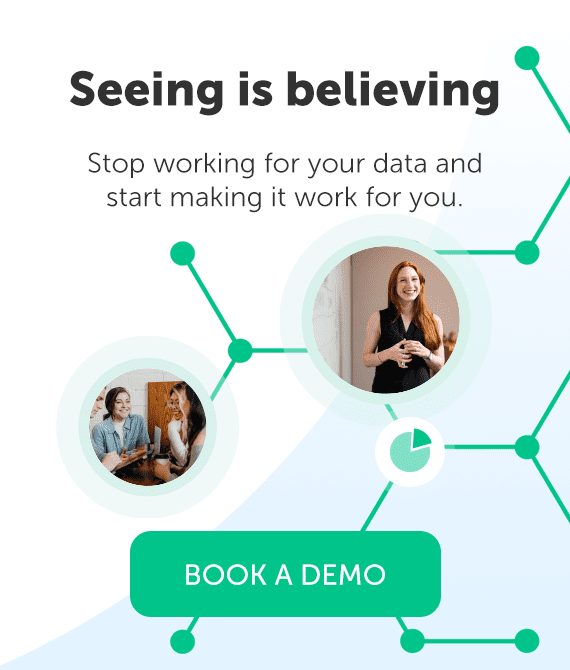You’ve heard about relationship mapping, and you’ve been told you need it, but so far nobody’s ever really explained that well what it is. Until now. Look no further for a crash course on relationship mapping covering the most important things you need to know:
- What is relationship mapping?
- Why do you need relationship mapping?
- Relationship mapping vs. relationship intelligence
- The foundation for relationship mapping is automation
- What are the benefits of relationship mapping?
- How modern relationship mapping works
What is relationship mapping?
Relationship mapping is the process of creating a visualization of the interconnected contacts within your organization. It highlights who knows who, how well they know each other, and other crucial relationship details, such as when they were last contacted and by whom. Essentially, it’s like the connection features on LinkedIn, but significantly more advanced and insightful.
This powerful tool, which leverages your customer relationship management system (CRM), helps paint a comprehensive picture of your organization’s relationships, keeping your intros warm and wins quick. With relationship mapping, you can make more informed decisions about your business activities.
Relationship maps become especially useful when dealing with complex deals involving numerous stakeholders. With an average of 11 people participating in a single purchasing decision, having complete visibility into relationships with key players gives you a competitive edge. This enables you to identify all involved parties, pinpoint your MVPs, and strategize the fastest route to success. In short, relationship mapping offers valuable insights that can drive your organization’s growth and strengthen your connections.
Why do you need relationship mapping?
When someone passes on your sale, there’s a good chance you might be to blame.
In the business world, potential clients say “pass” all the time due to weak relationships and lack of understanding. So do existing clients. It’s a convenient way to move decisions forward. The more complicated the decision, the more at stake, the more important relationships with all stakeholders become.
If you’re not nurturing these relationships, you can expect that people might start passing on you. If only you’d nurtured those relationships properly things might have gone differently. The key here is relationships, plural, with the s. Because it’s never up to just one person to make the decision.
With Gartner reporting that between 6 and 10 people now participate in the average B2B purchase decision—a number that keeps increasing—companies can no longer rely on the strength of one relationship to ensure business decisions go in their favour. It doesn’t work like that anymore. Most executives just aren’t willing to put their name on the line to overrule a buying committee. It’s too risky.
To win in the decision-by-committee era, companies need to understand the current needs, motivations and inter-relational dynamics of all the key players. Enter relationship mapping.
Relationship mapping vs. relationship intelligence
Relationship intelligence is an outcome of deploying automated relationship mapping tools to help companies:
- Win new clients
- Protect existing accounts
- Grow revenue among existing accounts
Traditionally, relationship mapping meant actually building out a visual chart of all the key stakeholders. You’d typically create a card for each stakeholder, including background notes, motivations, biases, etc. You’d then arrange the cards to show who reports to whom, using different symbols, color codes and line types (depending on your system and how complex you wanted to be) to indicate relationship type, relationship strength, internal alliances, influencers, conflicts, etc.
While this method of mapping relationship is a worthwhile tool and strategic exercise, the sheer complexity makes it difficult to execute, causing companies that could benefit from relationship maps to avoid them altogether. After the initial build, most visual relationship maps quickly become obsolete because updating them proves cumbersome and inefficient. Portability is also a challenge as the insights are typically housed in a centralized location.
Today, technology eliminates the need to create and manually update one-off visual maps. Instead, relationship mapping software tools create insights that are kept up-to-date automatically and delivered via email and mobile, the platforms sales and business development people use ubiquitously.
The foundation for relationship mapping is automation
Since modern relationship mapping is essentially automated relationship intelligence, there first needs to be actual intelligence to automate.
It’s not uncommon for companies in professional services, legal services, and financial services—the industries that benefit most from relationship mapping tools—to encounter issues with CRM adoption. This is a major roadblock because clean, timely data must go into the CRM if relationship intelligence is going to come out of it.

The solution is CRM automation, which eliminates an end user’s required CRM workload, ensuring clean, actionable data. With CRM automation in place, end-users finally realize the originally promised benefit of the CRM: usable relationship intelligence. Partners and executives are also thrilled because they can use relationship intelligence to grow business, but the biggest relief is that they finally start seeing an ROI from their massive CRM investment.
What are the benefits of relationship mapping?
Relationship mapping is a powerful tool that can improve your sales process, protect existing clients, and increase the return on investment (ROI) of your customer relationship management (CRM) system. In this section, we will explore the benefits of relationship mapping and how it can positively impact your organization.
1. Win new sales: Relationship mapping assists sales reps in approaching prospects with a strategic plan, making use of warm introductions that are five times more likely to engage B2B buyers than cold outreach. By scoring relationships, the platform identifies colleagues and contacts with the highest probability of providing the warmest leads, enabling an increased number of deals to be processed.
2. Protect existing clients: Relationship mapping enables you to pinpoint weak points in client relationships and take proactive measures to prevent client attrition. Low scores help monitor clients in need of nurturing and identify potential competitor interference. Enhanced retention rates can result in a 5% increase in customer retention, which translates to 25-95% more revenue.
3. Increased ROI on CRM: With automation, relationship mapping bolsters the productivity and performance of your revenue team by liberating them from tedious data entry tasks and guiding them toward greater efficiency and effectiveness. Consequently, your CRM yields superior insights to help grow revenue, relationships, and retention.
By implementing relationship mapping, your organization can reap numerous benefits, including winning new sales, protecting existing clients, and increasing the ROI on your CRM. Embracing relationship mapping can ultimately lead to enhanced productivity, efficiency, and growth.
How modern relationship mapping works
Relationship mapping has come a long way from its traditional, manual roots. Today, it leverages the power of automation and artificial intelligence (AI) to deliver valuable insights, streamline the sales process, and improve CRM adoption.
The modern approach to relationship mapping employs AI to analyze reliable data from your business communication platforms, such as email, VOIP, and calendar, as well as your CRM. This analysis helps uncover who has the strongest relationships within a target company, who can offer referrals, where there are opportunities to up-sell or cross-sell, when champion buyers change positions, and how to improve relationships with customers at risk of churn.
Automation has transformed relationship mapping from manual brainstorming to AI-driven analysis, generating a comprehensive and precise depiction of interconnected relationships. AI also provides a roadmap for effectively leveraging this information. In addition, automation addresses common CRM adoption challenges, such as time-consuming data entry, errors or missing elements in the data, and siloed information. AI effortlessly manages data entry, reduces human error, and presents a 360-degree view of all relationships, allowing executives, sales, marketing, and business development teams to access relationship intelligence on-demand or have it delivered.
The visual representation of a modern relationship map involves connections between colleagues and contacts in key accounts across your CRM. Behind the scenes, algorithms and AI score relationships using 20+ inputs, including volume of emails, meetings, seniority, frequency, and response time. This provides full visibility into key accounts and helps identify champions, leaders, and decision-makers who can facilitate introductions or referrals.
By implementing relationship mapping in your organization, you can unlock the full potential of your CRM and drive growth, efficiency, and success. This data can also be used to build hyper-targeted market segments by industry, geography, size, connected colleagues, and relationship scores, ensuring that you make the most of every touchpoint.

FAQ on relationship mapping
What is relationship mapping?
Relationship mapping is the process of creating a visualization of the interconnected contacts across your organization’s network. It highlights who knows who, how well they know each other, and other crucial relationship details, such as when they were last contacted and by whom. Essentially, it’s like the connection features on LinkedIn, but significantly more advanced and insightful.
This powerful tool provides a better understanding of an organization’s relationships at a given client account, client stakeholders who need to be engaged with, the dynamics between them, and who the best internal colleagues are to help facilitate that engagement to drive informed strategies, build meaningful relationships, and win more business.
Relationship maps become especially useful when dealing with complex deals involving numerous stakeholders. With an average of 11 people participating in a single purchasing decision, having complete visibility into relationships with key players gives you a competitive edge. This enables you to identify all involved parties, pinpoint your MVPs, and strategize the fastest route to success. In short, relationship mapping offers valuable insights that can drive your organization’s growth and strengthen your connections.
Why do you need relationship mapping?
Relationship mapping allows you to streamline account planning by mapping the buying committee relationships and understanding their decision-making dynamics to navigate complex engagements.
It also allows you to determine how to approach an opportunity, who has authority, what the strength of those existing relationships are, and what important relationships you’re missing.
What is the best relationship mapping tool?
Introhive stands out as the premier relationship mapping tool, and for good reason. Its advanced technology goes beyond merely plotting connections; it delves deep into the nuances of each relationship, providing actionable insights that can be pivotal for businesses.
Introhive’s platform is user-friendly, ensuring that even those new to relationship mapping can effortlessly visualize and analyze their network of contacts. Moreover, the tool embeds relationship and engagement insights alongside stakeholders within the map.With its robust features and commitment to accuracy, Introhive ensures that businesses can fully harness the power of their relationships to drive revenue growth.






